Design
Without changing underwater lines or deck arrangement significantly, we looked at
different accommodation and engine location arrangements, and eventually firmed up
on a very traditional aft cockpit, engine under the companionway, sea-
This arrangement allows adequate short-
For the rig, Mike recommended a “close-
For a “one off” hull, normal GRP moulding using a male plug and female mould is out-
All this time, Mike had been pressing me to make a “go or no-
This design programme allowed very little time for Owner’s review of drawings, and
it is a testament to Mike’s design that very few post-
Project Management
At this stage, although nominally retired, I still had four part-
Construction Concept
The UK boat-
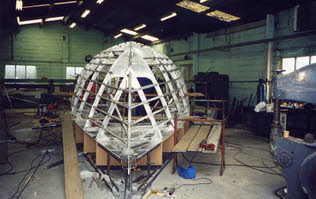 The first problem was to find an alloy fabricator with a good track record with round-
The first problem was to find an alloy fabricator with a good track record with round-
Aluminium Alloy Construction
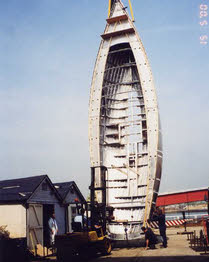 Although I had elected to be my own Project Manager, I felt a perceived need to employ
a Surveyor for the metalwork fabrication, principally to satisfy future insurers
and RCD compliance (more later!). I therefore employed Jim Pritchard, from Cowes,
who had a limited brief to inspect dimensional accuracy, fabrication and welding
procedures, material specifications, and weld testing.
Although I had elected to be my own Project Manager, I felt a perceived need to employ
a Surveyor for the metalwork fabrication, principally to satisfy future insurers
and RCD compliance (more later!). I therefore employed Jim Pritchard, from Cowes,
who had a limited brief to inspect dimensional accuracy, fabrication and welding
procedures, material specifications, and weld testing.
Feeling very exposed in the area of alloy design and recognising Mike Pocock’s lack
of experience with the material, I sought specialist expertise from a retired consultant
engineer with a lifetime in the aluminium design, welding and fabrication business,
Bill Allday. Bill reviewed the construction drawings (after Mike’s departure) and
recommended a host of small detail changes, mainly in fabrication method and detail.
Bill’s contribution was invaluable and a great confidence-
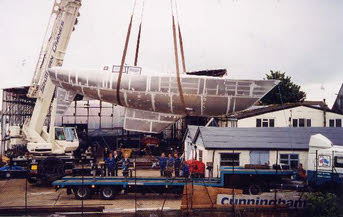
Cunninghams did a superb job and produced a very “fair” hull without any real problems or drama. They were about a month late on schedule, partly as a result of Bill Allday’s design changes and contract variations and partly due to the impact on the yard of another contract with more demanding penalty clauses!
The hull was completed in July 2000, loaded onto a low-
Fit-
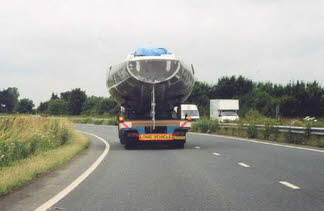 During the hull construction period I had been busy searching for and evaluating
builders for the fit-
During the hull construction period I had been busy searching for and evaluating
builders for the fit-
As David Skene had no building premises of his own, we agreed to rent a corner of
a large shed at Universal Shipyard, and to construct in it a scaffolding structure
covered with plastic sheeting. This became our build shed, and Project 2000’s home
for 8 months during the fit-
 For this contract I sought a fixed price for the labour element, based on my detailed
specification and scope of work, and reimbursable materials and equipment. I chose
this because I felt that a small builder would not take the risk of giving a fixed
price on materials without putting in a very hefty contingency which, to me as a
professional project manager, would be viewed as wasted money. I preferred to control
materials purchasing myself. As David was not VAT-
For this contract I sought a fixed price for the labour element, based on my detailed
specification and scope of work, and reimbursable materials and equipment. I chose
this because I felt that a small builder would not take the risk of giving a fixed
price on materials without putting in a very hefty contingency which, to me as a
professional project manager, would be viewed as wasted money. I preferred to control
materials purchasing myself. As David was not VAT-
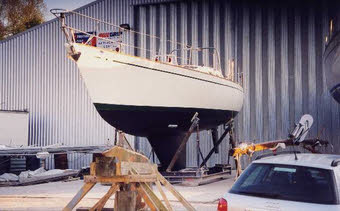 Throughout the job I was on-
Throughout the job I was on-
David did a superb job, and “Al Shaheen” was rolled out of the build shed in late April 2001 and launched on 18 May.
Recreational Craft Directive
 Even 5 years later, it is difficult for me to address this subject in an impassionate
manner. The European Recreational Craft Directive is a typical piece of Brussels-
Even 5 years later, it is difficult for me to address this subject in an impassionate
manner. The European Recreational Craft Directive is a typical piece of Brussels-
![]()
|
Design Specifications: | |||
|
|
Length overall |
12.86 m |
41.60 ft |
|
|
Waterline length |
10.08 m |
33.07 ft |
|
|
Beam |
3.75 m |
12.30 ft |
|
|
Draft |
1.89 m |
6.20 ft |
|
|
Sail Area |
72.57 sq.m |
781.17 sq.ft |
|
|
Displacement |
11096 kgs |
10.92 tons |
|
|
Fresh Water |
750 litres |
167 gallons (202 USG) |
|
|
Fuel |
325 litres |
72.2 gallons (87.8 USG) |
|
|
Actual cruising draft is about 1.95m or 6'5" | ||
|
Useful Links | ||
|
|
Skene Yacht Sevices | |
|
|
Sanders Sails | |
|
|
Jim Pritchard (Surveyor) | |
|
|
Michael Pocock |
4 Newenham Road Lymington SO41 8EQ Tel: +44 1590 675522 Mobile: +44 7903 507977 mike.pocock31@virgin.net |

ABOUT AL SHAHEEN
Concept
In 1989, my late wife, Su, and I had bought a new Tradewind 35, “Desert Wind”. Although we were then living in Saudi Arabia and the boat was kept in the UK, we managed to sail her for 5 to 6 weeks a year, and to cover about 1,500 miles a year, usually with our teenage family aboard and then later with Don Robinson as crew. We regularly cruised the north and west coasts of France, most of Ireland and the west coast of Scotland, returning to these locations year after year.
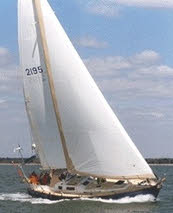 For some years I had been pursuing ideas for a bigger, faster and more modern cruising
boat and had exchanged ideas with several prominent designers, but had not taken
matters further, mainly because of commitment to my job in Saudi Arabia. After I
retired and after Su died, I was very restless, and felt the need for a major project
to occupy my mind and my time. It was at this time that I read reviews in the yachting
press of a 45 ft boat named “Troubadour”, designed by Michael Pocock, whom I had
met but didn’t know well. Everything I read about “Troubadour” seemed to gel with
my views as to what I wanted; she seemed the ideal fast and capable cruising boat.
I contacted Mike Pocock in February 1999 and we quickly began work on a similar boat
scaled down to 42ft which, at the time, I felt was the maximum size I could handle
single-
For some years I had been pursuing ideas for a bigger, faster and more modern cruising
boat and had exchanged ideas with several prominent designers, but had not taken
matters further, mainly because of commitment to my job in Saudi Arabia. After I
retired and after Su died, I was very restless, and felt the need for a major project
to occupy my mind and my time. It was at this time that I read reviews in the yachting
press of a 45 ft boat named “Troubadour”, designed by Michael Pocock, whom I had
met but didn’t know well. Everything I read about “Troubadour” seemed to gel with
my views as to what I wanted; she seemed the ideal fast and capable cruising boat.
I contacted Mike Pocock in February 1999 and we quickly began work on a similar boat
scaled down to 42ft which, at the time, I felt was the maximum size I could handle
single-
![]()
![]()